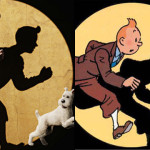OK, so it’s a very wordy title. Long gone are the days when you got a short, cryptic or ambiguous title to a movie, it seems. Maybe the studios think they need to make it as explicit as possible to cater for a dumbed down audience who won’t bother to watch unless the title all but tells them the entire plot? Shame to have relegated the original “Hergé’s Adventures of Tintin“, but beloved of the original books and TV series, to a mere “based on” the works of Hergé. Georges Remi, who died in 1983, must be pirouetting in his grave to find his nom de plume thus demeaned.
Anyway, the new Tintin movie comes in two flavours. As 3D is flavour of the month, it is one of those versions on offer, though frankly I hope it will have been forgotten and put to bed by this time next year. 3D is just an excuse to extract more money from the paying public without offering anything worthwhile. See one and you’ve seen them all. What counts is the skill of the director, cast, screenwriter, cinematographer, editor and the rest of the crew in combining to create a powerful, vivid and/or spectacular experience that enriches the lives of viewers. 3D does not compensate for a feeble script, bad acting or sloppy direction, and you really need to try iMax to get the best effects of 3D anyway. And as for “4D” in the Disney parks in Florida, I will leave you to imagine how horrendous that feels…
Since Spielberg had apparently long hankered to do a Tintin movie, you knew in advance that he would throw the kitchen sink at it, and indeed he does. Choosing CGI animation may seem to some another form of dumbing down, but trust me – it was inspired. This way, the camera swoops in and out of the action in ways that would have challenged even the inspirational Hitchcock in real live action.
The technology has come on in leaps and bounds since Toy Story 1, though even that was pretty darned impressive. Seems there is nothing now you can’t do with computer generation, and this is a tour de force example of light and shade in the subtle use of harnessed computer generation.
Of course, some concessions have been made to the cartoon roots of Hergé’s characters, notably buffoonish noses (from long and pointed to large and bulbous.) The Thompson twins seem to have gained much weight in the process, but sadly their pompous antics can’t compensate for the lack of laughs given by the trio of writers, including Steven Moffat, once of Joking Apart, Chalk and Coupling fame, more recently renowned for penning most of the new Doctor Who episodes.
Tintin himself seems to have been realised slightly more in the image of Jamie Bell, perhaps because he is voiced by the self same Jamie Bell, with plenty of derring do. In spite of his copious alcohol consumption, Captain Haddock seems less haggard and less belligerent than in the TV series, and in translation to the admirable Andy Serkis seems to have acquired a Scottish accent too. Snowy, as Tintin’s general factotum, eyes and ears, is highly mobile though somewhat less expressive than you might expect. The Thompson Twins (renowned duo Frost and Pegg) are every bit the slapstick bumbling detectives as ever they were. Plenty more well-known names grappling with age-old characters too.
That said, the realisation of the characters and situations is pretty darned good, baddies included (a dastardly role for Daniel Craig.) The complexity of plotting is up there with the standards Hergé set, so what, you may well be asking yourself, can possibly have detracted from giving this movie a glowing review?
Spielberg is clearly happiest with action sequences, hurling characters and objects into impossible situations, then magically extracting them against all the odds. He did it brilliantly in the Indiana Jones films, and does it better here. Sadly, he is less comfortable with the bits inbetween. The pace drags notably on occasions, and nothing Moffat and co can do spices up the movie sufficiently to maintain a consistently enthralling final product. Maybe it worked best as 20 minute episodes, each ending with a grippingly impossible situation from which our hero must escape (not unlike the episodes Dickens used to pen, come to think of it), but as a full-length 107 minute feature it comes out a trifle lumpy.
Perhaps the other surprising omission in a Hollywood epic is the lack of a love interest (and it is worth adding that M Remi was always somewhat misogynistic in the Tintin books too – little or no place for girls in his adventures.) In this, it is truer to the books than purists might admit. Possibly this is a nod towards the PG certificate and the younger audience who lined the multiplex screen where Adam and I saw said movie wall to wall. But it would have added complexity and layers to Tintin’s single-minded and possibly shallow personality.
So a good effort, albeit slightly flawed. However, coming back to the title, one suspects that the use of the colon indicates an intention to make further adventures of Tintin for the big screen, so maybe we will gain further insights into the psyche of our journalist hero? Watch this space, folks…





